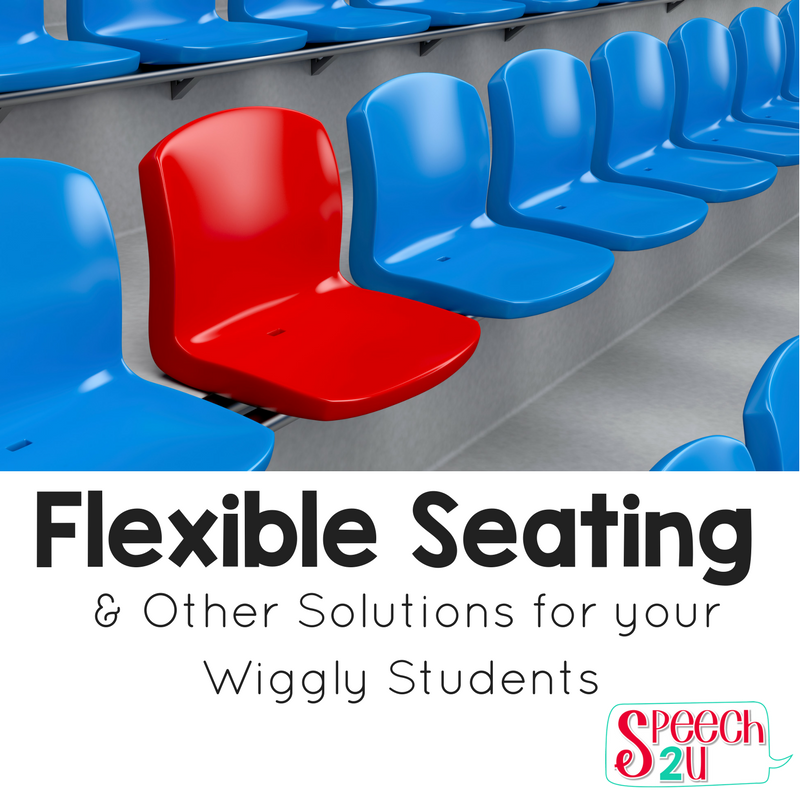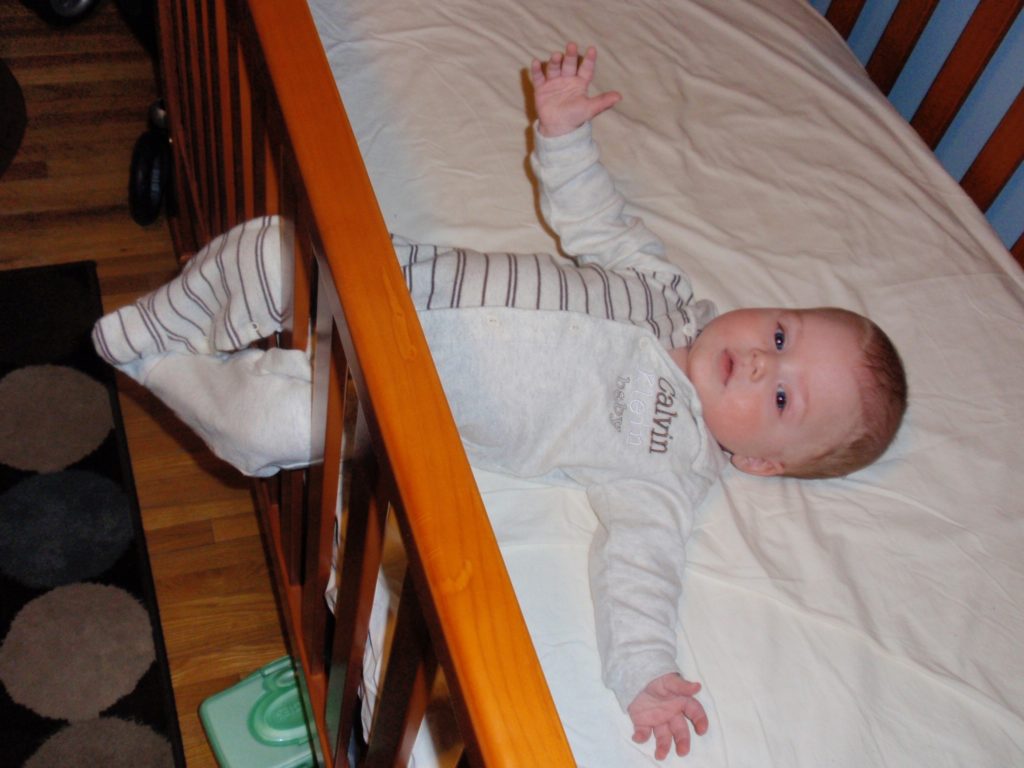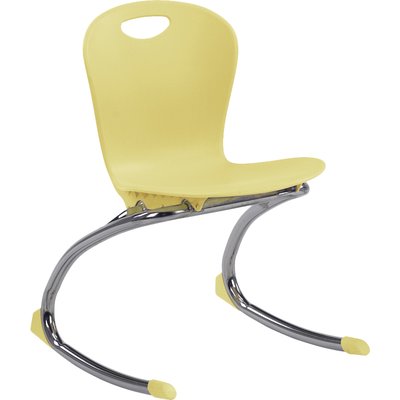
I got a letter from my son’s teacher last year. It said, “Your child has significant difficulty managing his hands and body to be safe in the classroom. Please talk about to him about this.”
*Sigh*
My son is 7, we’ve been talking to him about this for his whole life. As an infant, in his crib, he would move until his feet were sticking out of the slats in his crib. I’d wake up in the morning to find him doing this:

I talk to him about whole body listening, keeping his body in the group and the fact that HE is in control of his hands and body. He’s the kid that ran into the closet door at school, giving his teacher a heart attack and spending an hour in the nurses office-he didn’t really even feel it.
He’s also the child who is reading above grade level, has met his trimester one goals at the end of the semester one and while he sometimes can’t stop talking, when he is engaged in a task, he has a hard time pulling himself away from it. If we are watching TV, I sometime turn and see that his head is hanging off the couch and his feet are dangling up at the top. It drives me crazy too.
Have you ever “thera-pized” your child? Here is a small sampling of the interventions I’ve tried during his 3 years in the academic setting:
- Telling him to stop moving
- Telling him to think about where his body is in space
- OT consultation
- Social skills class with social worker (he learned how to quietly scratch his leg-which he said helps.
- Body in the group
- Expected/unexpected body behaviors
- Fidget cube
- Practicing sitting on the couch
- Going back to church to practice sitting during services
- Yelling at him for moving too much
- Sticker charts
- Gymnastics
- Karate
- More time at the park
- Buying a trampoline for the backyard
- Buying a slack line and Ninja zone equipment for the backyard
- No iPad/limited screen time
- Enrolling him in kid’s yoga
- Social Stories
As he gets older-he gets a little bit better-but I’ve come to the conclusion that he can’t stop moving. He might be able to control the amount and how much it distracts others-but he needs to move to learn. My experience as a mom to a master wiggler that has given me extra compassion for the students and clients I see who cannot seem to control their body or sit still. My son’s classroom teacher just redid her whole room using flexible seating-and it got me thinking about what we could do to help our wiggly kids out.
Do you have students with whom you work who just cannot sit still? If you are spending all day trying to get them to sit and attend-maybe you should try a different approach. Here are my top tips:
Have a Ball
One of my favorite activities is just bouncing a small racketball back and forth or tossing a bean bag back back and forth. Occupational therapists at my clinic use a program called Ball a Vis-X. It’s a series of progressively difficult bounce/catch sequences designed to improve eye hand/motor coordination. I’m not trained in the techniques-but I use several of the sequences to provide additional challenge and engage my clients in therapy. It’s easy to target conversation goals complete articulation drill during or in between catch sequences. Check out the movements HERE.
Take a Walk
If it’s allowed-or I’m by an empty hallway, I like to take a walk instead of sitting at the table. It works for conversational skills, categorization tasks and articulation. I am getting better at coming up with word list on the fly-although I always feel like the first word that pops into my head is a little inappropriate. It probably says something about my character that the first words that pop into my head are swear words.
Switch up your Location
Why sit at your speech table if you can sit underneath it? Sometimes switching the location or switching your table can engage your students in a different way. Check out some of my other ideas for switching up your speech space.
Whenever possible, I allow my students to stand up or add movement into our session-they have been sitting all day. There are some days where I need to take more data or I’m just tired. On those days I will try alternative chair sitting or flexible seating.
Alternative Chair sitting

Do you have a student that likes to tip the chair back to death defying angles? Let them stand on the chair in different but safe ways. I had a handout from an OT when my son was in kindergarten, which listed four different ways of sitting on a chair. I think it was from Lucy Jane Miller-but I’m not positive so I can’t cite the original source for this and just took pictures of my son on our dining room chair.
Flexible Seating Options
Flexible seating is moving to the classroom-could you modify it for your speech room? The idea behind flexible seating is to give the student a choice of where they can sit to work at their best. I think it would be pretty hard to facilitate a group with four kids sitting on a beanbag chair, wobble seat, t stool and a rug.
It reminds me of when I only sort of containerized my child (which is probably why he was so wiggly!). I would move him from the floor to the pack and play and then to the floor, bouncy chair, swing, bumble seat (PT’s don’t read that one!) and then try to swaddle him onto my body.
If you need your student to sit at the table, I found a few pretty cool options to check out.
The following pictures contain affiliate links. Affiliate links provide a small amount of money to the person providing the link-they don’t cost the buyer anything. As long as I’m linking, I figure I can try to earn a little money to help cover the costs of having this blog.
Theraband
If you have a student squirms during therapy, one of the easiest (and cheapest) methods, is to tie Theraband around the base of the chair. The picture below shows bouncy bands which you can add to the base of the chair. I’d double check the dimensions if you want to use these to make sure that they will fit on the type of chair you have in your therapy room.
Kore Wobble chairs
This chair allows the child to move while sitting and avoids the need for them to tip back in their chair. I’ve got this on my wishlist for my son.
Virco Rocking Chair
The chair allows the child rock gently while sitting. I like this chair because it looks similar to other classroom chairs-you can get it in a variety of colors and sizes.
Your occupational therapist will probably be much more helpful in coming up with solutions for seating. I look at these seating solutions because I frequently get asked by my son’s classroom teacher what they can try in class. If you have a student who has difficulty keeping still, I hope that you can use some of these suggestions. We can teach the cognitive concepts of brain/body in group while remembering that fidgeting and difficulty keeping still is not a behavior problem.
Question: What tips or tricks can you share when dealing with children who have difficulty keeping still. Leave your comment below for a chance to win a set of bouncy bands. I’ll pick a winner on Sunday, September 24!




Yes! flexible seating works in the speech room. I observed a student for a 60 minute session in a regular chair and he never stopped moving. We borrowed a Hokki stool and he made small movements throughout the session while staying seated on the stool, and attended well until the last 3 minutes of the 60 minute session. Another student I see has to have something to hold in his hands. I gave him one of those squeezy stress ball type toys and his movement went from all over the place to high pressured squeezing and minimal movement in the chair. I think flexible seating and fidgets are things we all can try. Then, teach your student which ones work for them. The students can advocate for themselves when they have practiced in the speech room. We practice every session. I don’t put out anyone’s special chair/fidget. They can go get it themselves, or ask for what they might need. I teach them to do the same thing in their classrooms.
Playdoh is a great activity that keeps kids still.
A good therapist can use playdoh for all therapy needs.
Another idea is using weighted wrist bands on their ankles. The weight helps the sensory system organize themselves. This does need to be approved by parents before you use them but it’s amazing the impact it has the sensory system to help organize the brain.
Good luck!
I love play-doh, that’s a great idea for helping children who need to sit still.
Such good ideas! I love the thought of teaching my students to advocate for what they need-such an important communication skill!